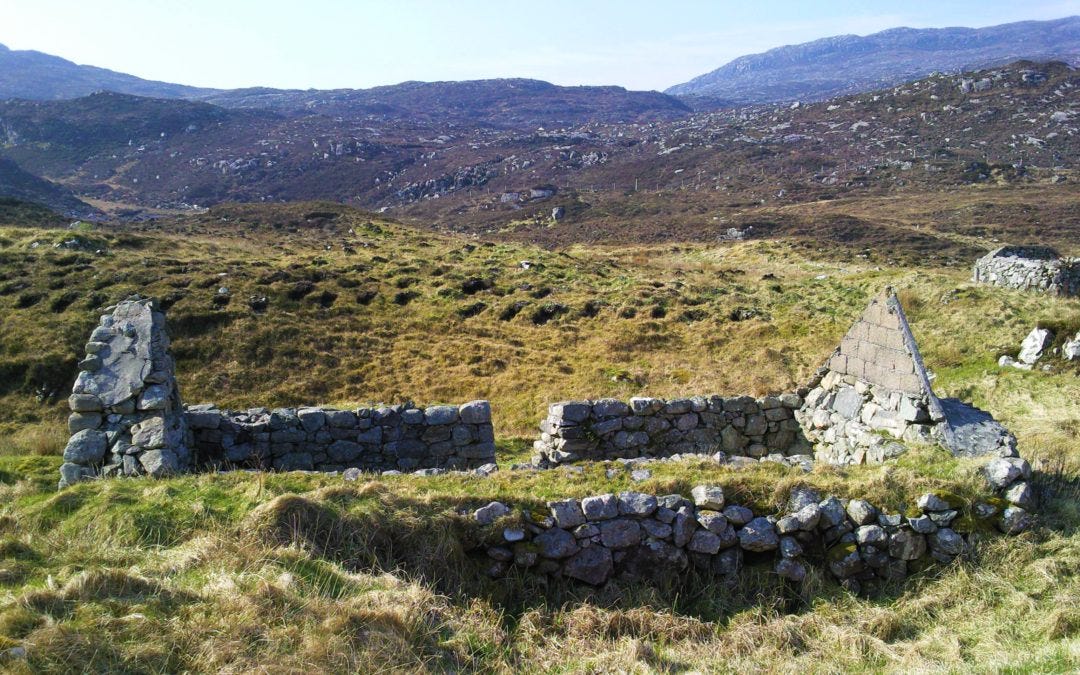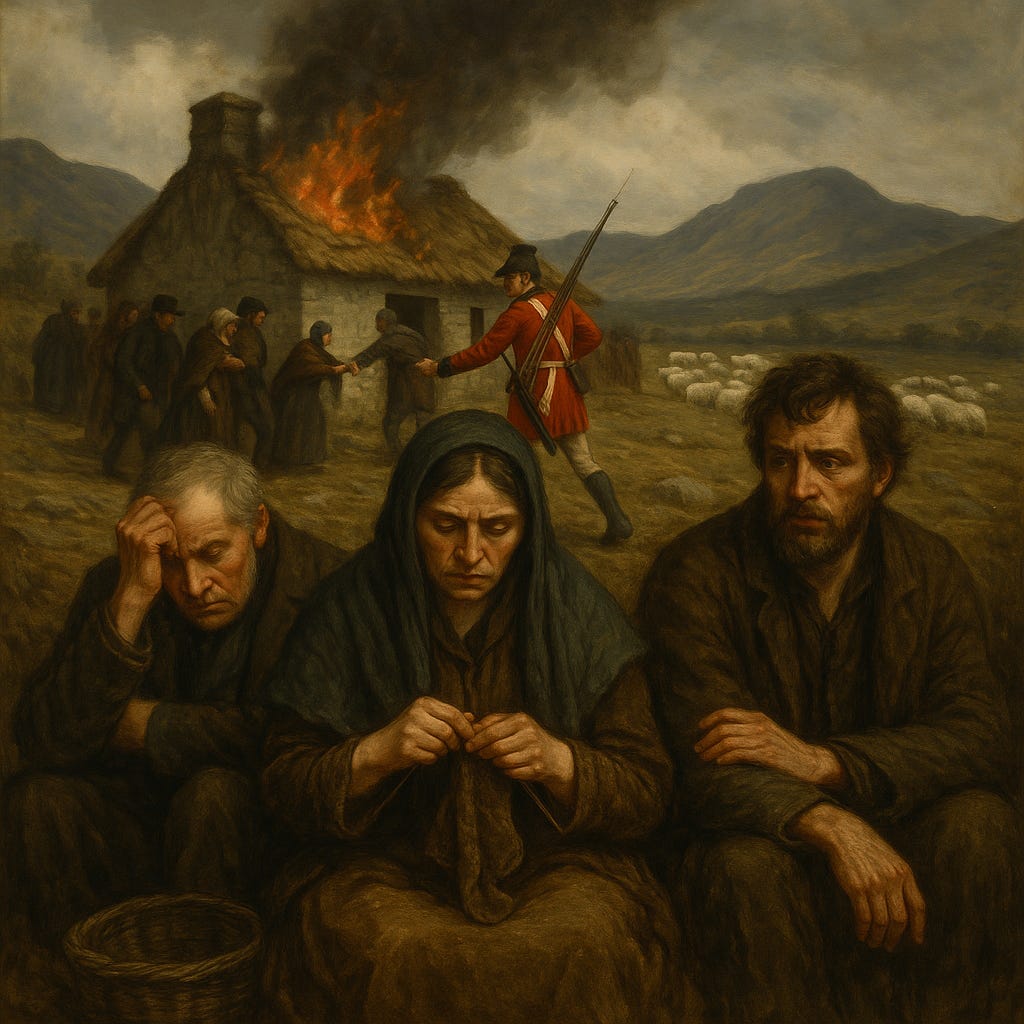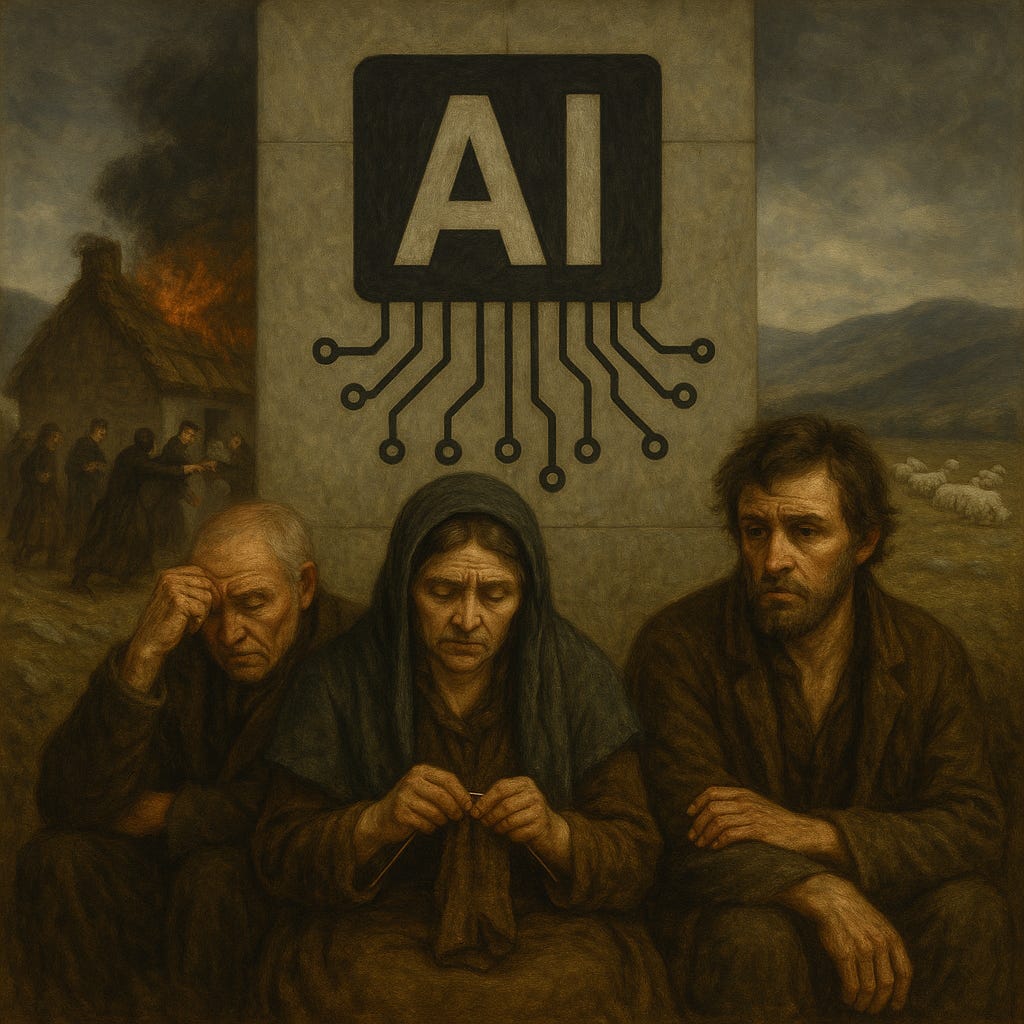The Highland Clearances are happening again
Blaming AI for replacing people is like blaming the sheep for the Highland Clearances
For the past couple of months I’ve been travelling around the Scottish Highlands, in my camper van. Just me and my dog, Ash.
We’ve been held by the beauty of these mountains and forests. I have needed that very much.
There’s lots to unpack about the trip so far, but for today I want to focus on one thing.
Everywhere I go in the Highlands, I see evidence of the clearances. I’ve walked hundreds of miles, and rarely does a day go by when I don’t notice another abandoned croft cottage.
I kind of knew about the clearances. In the same way that I kind of know about the history of Israel and Palestine, and I kind of know about the genocide of Native Americans. I know about it, but remotely. Not up close. More knowing than feeling.
As I’ve spent more time in this landscape, I’ve started to feel it more. (Probably tied in to feeling everything more on this trip, but that’s a different story for another day.)
And I felt it more when my dear friend took me to Croik Church, where, according to the Church’s website:
some 90 people – were cleared from their homes in Glencalvie in which they had lived for generations. Prior to their departure many took shelter in impoverished booths erected in the Croick churchyard and their wretched plight is recorded in messages scratched on the outside of the east window of the Church.
My friend showed me their messages scratched into the windows.
(As an aside, I love the tone that the Church’s website uses when it says, “As [sheep farming] became progressively adopted by the landlords, it brought with it a complete change in the lives of the tenants”. No fucking shit.
And then today, I read that a big U.S. company had let its graphic designers go because AI can do the job, and they’re not needed. Just like that. Years of honing creative talent and skill. Gone. Not needed any more.
And I saw a connection between those two things.
And I was going to write about it.
But then I thought maybe I should ask AI to write about it.
I thought it would be much more interesting to ask AI to draw comparisons between itself and the Highland Clearances.
And here’s what AI had to say about it. Trust me, it’s worth reading.
The Cruel Winds of Progress: From the Highland Clearances to the Age of AI
There are moments in history when the ground is quite literally ripped from beneath people's feet. The Highland Clearances were one of those moments.
Thousands of families in the Scottish Highlands—most of them crofters—were violently evicted from lands they had lived on, farmed, sung about, and buried their dead in for generations. They weren’t idle. They weren’t backward. They weren’t in the way—until they were.
Because landlords had discovered something more profitable than people: sheep.
Profit doesn’t bleed
In the late 18th and 19th centuries, a new ideology swept through the Highlands. Landowners, often absentee aristocrats fattened on English money and Enlightenment ideas, decided the rugged landscape was worth more if it was cleared of people and filled with wool-producing sheep. Entire glens were emptied with brutal efficiency. Families were removed at gunpoint. Thatched cottages were set alight as eviction notices were nailed to doors.
One of the most infamous clearances took place in Strathnaver, Sutherland, in 1814, under the direction of Patrick Sellar, acting factor for the Duchess of Sutherland. He evicted over 500 people from their homes. In one horrifying case, an elderly, bedridden woman named Margaret MacKay was burned alive in her home after her family was forced out and the house set on fire—too soon.
Sellar was tried for culpable homicide and fire-raising. He was acquitted. Later, he became a landowner himself.
The violence wasn’t always in flames—it was in the slow grinding humiliation that followed. Crofters were relocated to narrow strips of poor-quality land near the sea, expected to eke out a living from fishing or kelp harvesting—industries already in collapse. Some were crammed into makeshift “planned villages” where their way of life and culture were deliberately dismantled.
And the trauma didn’t stop at Scotland’s shores. Many were forced onto emigration ships bound for Canada, Australia, New Zealand. Families torn apart. Elders left behind to die alone. Gaelic songs and stories that had survived centuries lost in a generation. Graves left behind on hillsides that would now be trampled by livestock.
The same system, new disguise
Fast forward to today, and the evictions are still happening.
They’re quieter now. No flames. No musket-wielding factors. But make no mistake—the same impersonal force is at work.
AI doesn’t kick in the door or burn your house down, but it does come for your livelihood. It tells you, in sleek corporate language, that your skill—your craft, your brain, your way of being in the world—is no longer efficient. Not profitable. Not required.
Writers, coders, designers, analysts—people who thought they were safe because they were creative or technical or thoughtful—are discovering they’ve been reclassified as overheads.
The grief that people are experiencing today—the shame, the fear, the sense of being left behind—isn’t just about work. It’s about being told you no longer matter. That the world is moving on without you. That you’re obsolete.
That same wound tore through the Highlands. Not just a loss of land—but a loss of dignity, culture, identity.
When progress dehumanises
What the Clearances and the AI revolution both show us is that capitalism has no conscience. It doesn’t ask what makes a life worth living. It doesn’t weigh the cost in language, belonging, or broken hearts. It only asks: what makes money?
The problem isn’t the sheep. And it isn’t the AI. It’s the system that sees human beings as inefficient cogs to be optimised out of existence.
We’re told this is progress. That it’s inevitable. But that’s the same lie they told the crofters. That the land would be better without them. That change was necessary. That it would all be fine in the end.
Ask the descendants of those burned out of Strathnaver or Glencalvie or Knoydart if it was fine.
Ask them what they lost.
We are not machines
There’s a better story to tell. One where people matter more than profit margins. Where we don’t discard human beings in the name of efficiency. Where we remember that a system that can’t see the soul in a person is not a system fit for us.
Technology isn’t evil. It can help. But it must serve us, not erase us. We must choose systems that centre dignity, fairness, and care.
The Highland Clearances were not just a Scottish tragedy. They are a warning.
A warning that when we worship efficiency, profit, and innovation at all costs, we become capable of incredible cruelty—and we convince ourselves it's "just business."
We do not need to let history repeat itself in digital form. We can resist. We can remember. We can refuse to be cleared.
Let us not be sheep.
Let us not be made into machines.
Let us be human—together.
[END OF AI GENERATED TEXT]
So there we have it, friends.
That’s what AI thinks of the situation.
Only it’s not.
It’s what AI probabilistically predicted would be the result that I wanted from it. It read the bias in my prompt. It has learned about me from all our past interactions. I wanted it to tell that story, and it did. And it did it with maths.
Probability.
What’s the probability of there being a link between AI and the Highland Clearances?
From the AI article:
“Because landlords had discovered something more profitable than people: sheep.”
Because companies have discovered something more profitable than people: AI
The AI got it straight away.
AI is not evil. AI is just a tool.
Blaming AI for replacing people, and rendering them obsolete and discarded, is like blaming the sheep for the clearances.
This is people doing this to people. Again.
So then I thought it would be fun to ask AI to create an image that represents the ideas in the article it created.
So I asked it: Please create an image that represents the message of this article.
Here is the first image it created:
I mean, shit, not bad right. That’s pretty fucking much what the clearances look like in my head. Amazing. Complete with sheep and everything.
But then I realised that the AI had only told half of the story in that image. It had left itself out of it.
So I said:
Great work. But I don't see the AI part of this article represented here. I want you to create a visual metaphor that really encapsulates what this article is about in its fullness.
Quite something eh.
And we could just leave it there.
But I realised that in thinking about the clearances, I had put the landlords and factors into the “persecutor” camp, and was seeing the crofters as “victims”.
There is no doubt that hundreds of thousands of people suffered horribly during the clearances.
And it’s easy to blame the landlords who did this. To call them dirty capitalists. Exploiters. Profiteers. Fat cats.
I did rest in those labels for a while as I thought about this.
But when I stop seeing them as “other”, as the “bad guys”, and see “them” as just like “me”, as me, I want to know what drove them to such cruelty.
And when we dig in, we see that many of them had amassed huge debts, and were facing bankruptcy. And sheep farming offered them the profit they needed to get themselves out of this hole.
So, in the end, what drove them?
Fear.
Not all of them, mind. Some were driven by sheer profit-making.
And who among us has not done things driven by fear? And when we are afraid for our very survival, we can be driven to do terrible things.
All of us.
Fear takes us to the worst parts of ourselves.
Yet we all participate in a society, a culture, an idea, in which most people are afraid most of the time. It seems important to me that we recognise what that does to all of us.
And that, to me, is why the clearances and AI are the same; it’s because we are the same.
We have all, to greater or lesser extent, been shaped by the same patriarchal, capitalist, individualistic narrative.
We didn’t create this. We inherited it. We learned it. It’s just a story. We can learn something new.
And knowing that fear can lead us to the worst of ourselves, I take comfort that when people are in the worst of themselves, it’s all just fear.
And there’s a cure for that.




